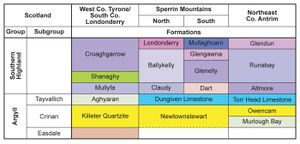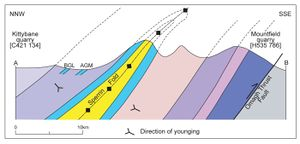Southern Highland Group, Dalradian Supergroup, Central Highlands (Grampian) Terrane, Northern Ireland
| Mitchell, W I (ed.). 2004. The geology of Northern Ireland-our natural foundation. Geological Survey of Northern Ireland, Belfast. |
M R Cooper and T P Johnston
Introduction















The Southern Highland Group is the youngest stratigraphical division of the Dalradian in Ireland and Scotland. The stratigraphy of the Southern Highland Group is less clearly defined than the Argyll Group and consists of a thick succession of turbiditic arenites and pelitic metasediments with rare volcaniclastic (green bed) and calcareous schist units. In the Sperrin Mountains the stratigraphy of the Southern Highland Group differs markedly across the axial trace of the recumbent Sperrin Fold (P948093) and (P948094). An absence of distinctive marker horizons allied to lateral facies changes makes correlation difficult between formations and results in the different nomenclature north and south of the fold axis (P948093) and (P947914).
South Sperrin Mountains
South of the axial trace of the Sperrin Fold the Southern Highland Group comprises four formations (P947915). The rocks lie on the inverted southern limb of the major regional Sperrin Fold (P948094). The transition from the underlying Dungiven Limestone Formation (Argyll Group) into the lowest levels of the Dart Formation can be traced from Butterlope Glen to the summit of Mullaghcarbatagh [H 518 949]. At the base of the Dart Formation [1] is the Glenga Amphibolite Member (P947915), which is interpreted as a locally resedimented volcaniclastic siltstone and sandstone (P947963). The remainder of the formation consists of granule to pebble size conglomerate (P947964), psammite with graded bedding, schistose semipelite and the volcaniclastic Henry’s Bridge Member.
The Glenelly Formation comprises silvery to greenish grey schistose pelite and semipelite with minor psammite and limestone. Plagioclase porphyroblasts (albite-oligoclase) are ubiquitous in the rocks of this formation with more localised occurrences of small euhedral garnet and randomly distributed needles of tourmaline. There are four lithologically distinctive members which reflect variations in the depositional environment (P947915). The Oughtboy Burn Member is a volcaniclastic unit (green bed) which indicates a change in the sediment source, possibly to a basic igneous hinterland. The Clogherny, Golan Bridge and Garvagh Bridge members all contain beds of limestone and schistose calcareous semipelite indicating episodes of basin shallowing in the midst of essentially deeper water sedimentation.
The Glengawna Formation (P947914) is about 400 m thick and is well exposed in Glendarragh Burn [H 591 892] in Glenlark, 5.5 km ENE of Gortin [1]. The base of the formation is marked by the contrast between silvery grey lithologies of the Glenelly Formation and the black graphitic schistose pelites of the Glengawna Formation. At higher levels in the formation, pale grey quartzose psammite, semipelite and grey graphitic schistose pelite grade up into the Mullaghcarn Formation.
The Mullaghcarn Formation, the highest formation in this section in the south Sperrin Mountains (P948093) also forms the Lack Inlier, west of Omagh [1][2] and consists of schistose semipelite, psammite and pelite. Bedding is not easily recognisable and the rocks show evidence of increasing strain close to the Omagh Thrust Fault. Garnet porphyroblasts from the D1 deformation are common in the Lack Inlier and are rotated passively by an S2 cleavage with a later overprint by biotite. Hornblende-bearing green beds occur close to the top of the formation at Largy [H 282 661].
North Sperrin Mountains and North Co. Londonderry
North of the axial trace of the Sperrin Fold the Southern Highland Group is divided into three formations ((P948093) and (P947916)). Bedding dips are towards the north and the rocks young northwards in a normal stratigraphical succession (P948093). The basal Claudy Formation is exposed in Kildoag quarry [C 497 084], 4.5 km WNW of Claudy and consists of psammite units up to 1m thick alternating with laminae of silvery grey phyllitic semipelite and rare layers of greyish black phyllitic pelite up to 1m thick. The presence of chlorite, white mica and biotite porphyroblasts indicates metamorphism under upper greenschist facies conditions. Two limestone units form markers in the Claudy Formation. The Alla Glen Limestone Member is exposed in the partially flooded quarry at Drain [C 458 019], 2km southeast of Dunnamanagh and the Bonds Glen Limestone Member in quarries in Bond’s Glen [C 491 067], 5km west of Claudy. Bedding surfaces are conspicuous in the limestone and phyllitic semipelite layers preserve a coplanar slaty cleavage (S1). Both surfaces are crenulated by a northwards-dipping S2 cleavage that is axial planar to minor F2 folds plunging towards the ENE. The top of the Claudy Formation is exposed in the Crunkin Burn at Ervey [C 522 121] and is marked by a thin epidote-rich volcaniclastic semipelite (green bed) [3].
The base of the succeeding Ballykelly Formation is marked by the Baranailt Limestone Member which is exposed in a stream [C 635 148] on the northeast flank of Glenconway Hill [4]. Structurally the Ballykelly Formation is situated on the southeast limb of the Lough Foyle Syncline (P947793). The formation is exposed in Kittybane quarry [C 421 134] 1km northeast of New Buildings. At The Dog’s Leap, on the River Roe [C 674 204] south of Limavady, mixed psammite and pelite show the regionally penetrative S2 cleavage strongly crenulating and transposing an earlier composite bedding/S1 (pressure solution) fabric.
The outcrop of the succeeding Londonderry Formation lies at the core of the Lough Foyle Syncline (P948093) with typical lithologies (P947916) exposed in Prehen quarry [C 423 147] southwest of Londonderry. These rocks have experienced relatively low levels of metamorphism and the dominant fabric is a penetrative S2 cleavage that is sub-parallel to a composite bedding/S1 fabric but dips more steeply to the northwest. The S2 cleavage is axial planar to southeasterly verging minor folds and its intersection lineation with the earlier fabric plunges at up to 15º to the northeast. Sedimentary structures such as grading are common and these, combined with bedform geometry, indicate that the strata are the right-way-up and young to the northwest.
West Co. Tyrone
The Dalradian succession of central and south Donegal [5] extends south and eastwards into west Co. Tyrone and south Co. Londonderry [6]. In west Co. Tyrone the Dalradian rocks lie on the inverted southern limb of the Ballybofey Nappe (P947792). The youngest strata (P947917) are thrust southeastwards over the Moinian rocks of the Lough Derg Inlier along the Lough Derg Slide [7].
The lowest stratigraphical unit in west Co. Tyrone, the Killeter Quartzite Formation (Argyll Group), is correlated with the Newtownstewart Formation in the Sperrin Mountains [8].
The most distinctive lithostratigraphical unit in west Co. Tyrone, the Aghyaran Formation (P947917), is equivalent to the Dungiven Limestone Formation in the Sperrin Mountains and the Torr Head Limestone Formation in northeast Co. Antrim.
The Southern Highland Group in west Co. Tyrone is divided into three formations (P947917). Extensive exposures of all three formations occur in the vicinity of Tievenameenta [H 164 758] ENE of Lough Derg (P947792). The distinctive mixed lithologies of the Shanaghy Formation, and its contacts with adjacent formations, can be traced north for 2 km from the sub-Carboniferous unconformity [H 166 753], onto the east flank of the hill at Tievenameenta. Lying east of the outcrop of the Shanaghy Formation are scattered exposures of the Mullyfa Formation while the Croaghgarrow Formation is exposed on the hill at Tievenameenta. The widespread occurrence of garnet and biotite in west Co. Tyrone indicates that metamorphic grade is in the upper greenschist to lower amphibolite facies. Kyanite also occurs in the Croaghgarrow Formation as bladed crystals up to 2 cm long in schist and as felted masses in tourmaline-rich pegmatites, on the east bank of the Leaghany River [H 096 755], suggesting that locally the metamorphic grade may have reached the lower or middle amphibolite facies.
Northeast Co. Antrim
The Dalradian inlier in northeast Co. Antrim [9] is unconformably overlain by Carboniferous, Cretaceous and Palaeogene strata at its margins (P948095). The succession, which is divided into six formations (P947918), lies on the lower, inverted limb of the Altmore Anticline (P947793) and (P948095) which is regarded as the southwesterly continuation of the Cowal Anticline from southwest Scotland [10], [11].
The lowest two formations of the Argyll Group, the Murlough Bay and Owencam formations, consist mainly of coarse-grained schistose psammite and semipelite. The most distinctive and youngest unit in the Argyll Group is the Torr Head Limestone Formation (P947965) and (P947966), which correlates with the Dungiven Limestone Formation in the Sperrin Mountains, the Culdaff Limestone in Co. Donegal and Loch Tay Limestone in Scotland [12]. Clastic sediments in the limestone and at the base of the overlying Altmore Formation indicate deposition on a shallow marine, storm-influenced shelf.
The Southern Highland Group in the inlier is represented by the Altmore, Runabay and Glendun formations which consist mainly of pebbly and coarse-grained psammite. Although the sediment at the base of the Altmore Formation was deposited in shallow water the remainder of the Southern Highland Group succession was deposited as turbidite fans in a rapidly subsiding basin. The Runabay Formation contains two distinctive volcaniclastic (green bed) members. At the base of the formation the Carnaneigh Green Bed Member consists of pale grey and green bedded schistose chlorite-epidote rich semipelite. The Leckpatrick Green Bed Member occurs at the top of the formation and comprises mid- to dark green, schistose, chlorite-hornblende rich semipelite with albite and biotite porphyroblasts [13]. Both green bed members are composed of volcaniclastic material derived by erosion of coeval extrusive and intrusive mafic rocks or from contemporaneous basic volcanicity.
References
- ↑ 1.0 1.1 1.2 Geological Survey of Northern Ireland, 1995. Draperstown, Northern Ireland Sheet 26. Solid Geology. 1:50 000. (Keyworth, Nottingham: British Geological Survey).
- ↑ Geological Survey of Northern Ireland, 1995. Omagh, Northern Ireland Sheet 33. Solid Geology. 1:50 000. (Keyworth, Nottingham: British Geological Survey).
- ↑ Arthurs, J W. 1976. The geology and metalliferous mineral potential of the Sperrin Mountains area. Geological Survey of Northern Ireland, Special Report
- ↑ Geological Survey of Northern Ireland, 1981. Limavady, Northern Ireland Sheet 12 and part of Sheet 6. Solid. 1:50 000. (Southampton: Ordnance Survey for the Geological Survey of Northern Ireland).
- ↑ Alsop, G I, and Hutton, D H W. 1990. A review and revision of Dalradian stratigraphy in central and southern Donegal, Ireland. Irish Journal of Earth Sciences. 10, 181–98.
- ↑ Geological Survey of Northern Ireland, 1994. Kesh, Northern Ireland Sheet 32. Solid Geology. 1:50 000. (Keyworth, Nottingham: British Geological Survey).
- ↑ Alsop, G I, and Hutton, D H W. 1990. A review and revision of Dalradian stratigraphy in central and southern Donegal, Ireland. Irish Journal of Earth Sciences. 10, 181–98.
- ↑ Geological Survey of Northern Ireland, 1997. Northern Ireland. Solid Geology (second edition). 1:250 000. (Keyworth, Nottingham: British Geological Survey).
- ↑ Geological Survey of Northern Ireland, 2002. Ballycastle, Northern Ireland Sheet 8. Solid Geology (second edition). 1:50 000. (Keyworth, Nottingham: British Geological Survey).
- ↑ Wilson, H E. 1972. The Regional Geology of Northern Ireland. HMSO, Belfast.
- ↑ Arthurs, J W. 1976. The geology and metalliferous mineral potential of north-east Antrim. Geological Survey of Northern Ireland, Special Report
- ↑ McCallien, W J. 1931. A contribution to the correlation of the Dalradian rocks of Scotland. Geological Magazine. 68, 153–75.
- ↑ Wilson, H E, and Robbie, J A. 1966. Geology of the Country around Ballycastle. Memoir of the Geological Survey of Northern Ireland. HMSO, Belfast.